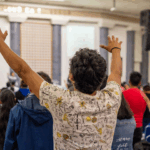In Samaritan literature, the split from the southern kingdom is traced back to the time of Eli, the priest at the time of Samuel (1 Sam 1—2). In the literature of the southern kingdom, the split is dated later, to the 8th century exile of the northern kingdom (2 Kings 17). The other nine tribes all became considered as apostate by the Samaritans.
Samaritan worship was based at a Temple on Mount Gerizim, a site which is referred to at Deuteronomy 11:29 and Joshua 8:33. This is a mountain near to modern-day Nablus (previously Shechem), on the West Bank. The Samaritans considered Mt Gerizim to be the highest and oldest mountain of the world (but it is 881m high, less even than the neighbouring mountain of Ebal, at 951m).
The temple was destroyed in 110 BCE during the aggressive expansion of the Hasmonean kingdom (based at Jerusalem). The destruction of the sanctuary and the city on Mount Gerizim deepened the rift between Samaritans and Jews.
For Jews during the Second Temple period, 2 Kings 17:24-41 explained the origin of the Samaritans. After the Assyrians sent the inhabitants of the northern kingdom into exile in 722 BCE (2 Ki 17:1-6), they resettled the area with pagans from other nations (2 Ki 17:24). These people, of course, brought their own religions. But the Assyrians recognised the need for these new inhabitants to worship the ancestral god(s) of the land, and so they sent exiled priests back to the land to instruct the people of the ancestral religion (2 Ki 17:25-28).
In the eyes of the southern author of 2 Kings, this was completely unacceptable, for the people “worshipped the Lord … and sacrificed in the shrines of the high places” (2 Ki 17:29-33). This unacceptable behaviour continued: “to this day they continue to practice their former customs. They do not worship the Lord and they do not follow the statutes or the ordinances or the law” (2 Ki 17:34). The southern antagonism towards the northerners is also reflected at Ezra 4:1-5.
We can trace ahistory of continuing antagonismin the writings of Flavius Josephus, a late 1st century CE historian. He notes disagreement about which site should be the location for the temple (Josephus, Jewish Antiquities 12.9-10); the same issue is reflected at John 4:20-22.
Josephus tells of a time when some Samaritans scattered bones of dead people in the in portico of the Jerusalem Temple, thus rendering it unclean (Antiquities 18.29-30), and he gives a graphic description of the time when Cumanus (governor of Judea 48-52 CE) was bribed by some Samaritans, leading some Judean brigands to mount an uprising. Cumanus ordered the Romans to join with the Samaritans in battling the Judeans; many were killed, many more taken captive (Antiquities 20.118-123).
Jewish disdain for the Samaritans is clear in a number of places in the Mishnah, a third century CE collection of legal opinions handed down by teachers of the law (later, Rabbis). In these texts, Samaritans are equated with Gentiles “who eat the flesh of swine” (Shebith 8.10); along with Gentiles, women, slaves and minors, they are excused from any responsibility to pay the temple tax (Shekalim 1.5); Samaritans are not recognised as authentic witnesses to most writs (Gittin 1.5); and in matters of marriage, Samaritans are placed in the same category as shetuki and asufi, categories of people whom Jews are firmly prohibited to marry (Kiddushin 4.2-3).
These points of view are what lay behind the insult thrown at Jesus, that he was a Samaritan, possessed by a demon (John 8:48). It was a great slander.
The name Samaritan is another pointer to this rivalry and antagonism between north and south. The word Samaritan is claimed to come from the Hebrew word shamerim (ַש ֶמ ִרים ), from the root word SMR (שמר) which means “to watch, to guard, to keep”. Thus, the name indicates that the Samaritans saw themselves as “the true keepers of the Law”. On the other side, we find the same term (shamerim) used at 2 Chronicle 13:11 to refer to the Levitical priests at Jerusalem, who keep the traditions of the Law alive in the worship in Jerusalem. Who was the true keeper of the Law??
The Samaritan Pentateuch
The Samaritan Bible consists of just the first five books (Genesis to Deuteronomy), in the same way that the Sadducees accepted only the five books of Moses. The Samaritan Bible is written in a different dialect of Hebrew. The Sadducees reject the idea of the resurrection, because it is not mentioned in any of these books of scripture. The Samaritans note that these books do not ever refer to Jerusalem, but they do refer to Mount Gerizim (Deut 11:29, 27:12). That explains their fervent preference for Gerizim as the holy mountain where the temple is to be located.
In the 5th century, a Christian invasion of the area led to the building of a Christian church in honour of Mother Mary on Mount Gerizim. Throughout the Byzantine period, there are numerous indications of a widespread, Greek-speaking Samaritan diaspora; evidence has been found in Delos, Egypt, Asia Minor, and Italy. The situation of the Samaritans improved under Islamic rule, but in the course of time, their numbers dwindled. There might have been a million Samaritans at the time of Jesus.
There are barely a few hundred today.
Moses has a prominent role in Samaritan literature. In “The Birth of Moses” (Molad Mosheh), Moses is described in glowing terms very much like the way Jesus is exalted in Christian traditions. “The prophet of the Lord is born in whom is His Favour; the Select of creation is born; the Man of God is born; the Servant of the Lord is born; the One Chosen out of all the prophets is born; the Prophet of the world and of its end is born.” The Samaritans look to the time when Moses will return as the Taheb, the Restorer, who will restore God’s sovereign rule over all the earth and bring universal peace.
Today, only a few hundred Samaritans live on Mount Gerizim and in Holon, near Tel Aviv. They observe the sabbath and continue to offer animal sacrifices each Passover. They maintain customs based on a strict interpretation of the purity laws in Leviticus; they marry only amongst themselves, for instance.
John Squires is the Presbytery Minister (Wellbeing) for Canberra Region Presbytery. This piece originally appeared on his blog, An Informed Faith.












